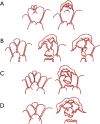Ischemic mitral valve prolapse
- PMID: 28149574
- PMCID: PMC5227273
- DOI: 10.21037/jtd.2016.12.33
Ischemic mitral valve prolapse
Abstract
Ischemic mitral prolapse (IMP) is a pathologic entity encountered in about one-third among the patients undergoing surgery for ischemic mitral regurgitation (IMR). IMP is generally the result of a papillary muscle injury consequent to myocardial, but the recent literature is progressively unveiling a more complex pathogenesis. The mechanisms underlying its development regards the impairment of one or more components of the mitral apparatus, which comprises the annulus, the chordae tendineae, the papillary muscle and the left ventricular wall. IMP is not only a disorder of valvular function, but also entails coexistent aspects of a geometric disturbance of the mitral valve configuration and of the left ventricular function and dimension and a correct understanding of all these aspects is crucial to guide and tailor the correct therapeutic strategy to be adopted. Localization of prolapse, anatomic features of the prolapsed leaflets and the subvalvular apparatus should be carefully evaluated as also constituting the major determinants defining patient's outcomes. This review will summarize our current understanding of the pathophysiology and clinical evidence on IMP with a particular focus on the surgical treatment.
Keywords: Mitral valve; functional mitral regurgitation; ischemic mitral regurgitation (IMR); prolapse; surgery.
Conflict of interest statement
The authors have no conflicts of interest to declare.
Figures



References
-
- Nishimura RA, Otto CM, Bonow RO, et al. 2014 AHA/ACC guideline for the management of patients with valvular heart disease: executive summary: a report of the American College of Cardiology/American Heart Association Task Force on Practice Guidelines. J Am Coll Cardiol 2014;63:2438-88. 10.1016/j.jacc.2014.02.537 - DOI - PubMed
Publication types
LinkOut - more resources
Full Text Sources
Other Literature Sources
